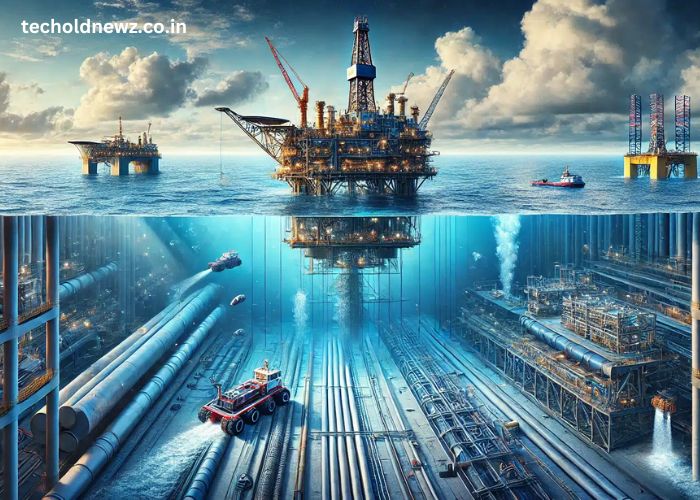Deep offshore technology has revolutionized how we explore and utilize resources in the ocean. This field focuses on innovative tools and systems for oil, gas, and renewable energy production in deep-sea environments. With advancements in engineering and science, deep offshore technology plays a crucial role in meeting the world’s energy demands while addressing environmental challenges.
Key Points:
- Deep offshore technology enables resource extraction in extreme underwater environments.
- Innovations like autonomous systems improve efficiency and safety.
- Sustainable practices are becoming integral to offshore operations.
What Is Deep Offshore Technology?
Deep offshore technology refers to specialized tools, equipment, and processes designed for underwater exploration and resource extraction at depths exceeding 500 meters. These technologies are essential for industries like oil and gas, wind energy, and marine research.
Key Components of Deep Offshore Technology
1. Subsea Equipment: Subsea systems, such as blowout preventers (BOPs) and subsea trees, manage oil and gas flow beneath the seabed. For example, BOPs are critical in preventing blowouts during drilling operations.
2. Autonomous Underwater Vehicles (AUVs): AUVs are robotic systems that conduct underwater surveys, inspect pipelines, and gather data. These vehicles operate without human intervention, enhancing efficiency.
3. Floating Production Storage and Offloading (FPSO): FPSOs are vessels that extract, process, and store oil. They are ideal for remote offshore locations where pipelines are impractical.
4. Offshore Wind Turbines: Deep-sea turbines generate renewable energy by harnessing wind power far from coastlines. These turbines can withstand harsh marine conditions.
| Technology | Function | Example |
|---|---|---|
| Subsea Equipment | Controls underwater oil/gas flow | Blowout Preventer (BOP) |
| Autonomous Underwater Vehicles | Surveys and inspections | REMUS AUV |
| FPSO | Extracts, processes, and stores oil | Shell’s Prelude FLNG |
| Offshore Wind Turbines | Generates renewable energy | Hywind Scotland Turbines |
Note: Efficient use of deep offshore technology ensures better resource management and environmental safety.
How Does Deep Offshore Technology Ensure Safety?
Safety is a top priority in deep offshore operations. Extreme underwater conditions, such as high pressure and low temperatures, require robust safety measures.
1. Advanced Monitoring Systems: Sensors and cameras monitor offshore operations in real-time, reducing risks like equipment failure or oil spills.
2. Remote Operated Vehicles (ROVs): ROVs are remotely controlled machines used to inspect and repair underwater infrastructure. They reduce the need for divers in hazardous conditions.
3. Emergency Response Systems: Technologies like automatic shut-off valves and gas detectors minimize the impact of accidents. For instance, automatic shut-off valves can prevent blowouts by stopping oil flow instantly.
4. Training Simulations: Virtual reality (VR) simulations train personnel for emergency situations. These simulations replicate scenarios like oil spills and equipment failures, ensuring teams are well-prepared.
Reminder: Investing in safety innovations not only protects workers but also safeguards the environment.
What Are The Environmental Impacts Of Deep Offshore Technology?
While deep offshore operations offer energy solutions, they also impact marine ecosystems. Innovations aim to minimize these effects and promote sustainability.
1. Eco-Friendly Drilling Techniques: Advanced drilling methods, like slimhole drilling, reduce waste and lower seabed disturbance. These techniques are more precise and efficient.
2. Carbon Capture and Storage (CCS): Offshore platforms capture CO2 emissions and store them beneath the seabed, reducing greenhouse gases. For example, Norway’s Sleipner Field uses CCS technology effectively.
3. Biodiversity Monitoring: AUVs equipped with cameras and sensors monitor marine life near offshore sites. This data helps companies reduce their ecological footprint.
4. Renewable Energy Integration: Offshore wind farms and wave energy systems offer clean alternatives to fossil fuels. Projects like the Hornsea Wind Farm demonstrate the potential of offshore renewable energy.
| Impact | Mitigation Technology | Example |
| Seabed Disturbance | Slimhole Drilling | Precision Drilling Tools |
| Greenhouse Gas Emissions | Carbon Capture and Storage (CCS) | Sleipner Field CCS |
| Marine Biodiversity Disruption | Biodiversity Monitoring AUVs | Marine Life Monitoring Drones |
| Dependency on Fossil Fuels | Offshore Renewable Energy | Hornsea Wind Farm |
Note: Sustainable practices ensure that offshore operations coexist with marine ecosystems.
What Are The Future Trends In Deep Offshore Technology?
The future of deep offshore technology is shaped by innovation, sustainability, and digitalization. Here are some trends transforming the industry:
1. Digital Twins: Digital twins are virtual replicas of offshore platforms that simulate real-world operations. They help optimize performance and predict maintenance needs. For instance, BP’s Clair Ridge project uses digital twin technology.
2. AI and Machine Learning: AI systems analyze data from sensors and predict equipment failures, improving operational efficiency. Machine learning algorithms also enhance drilling accuracy.
3. Autonomous Offshore Platforms: Fully automated platforms reduce the need for human presence, improving safety and efficiency. These platforms use advanced robotics and AI systems.
4. Hybrid Energy Systems: Combining renewable energy with traditional offshore systems is a growing trend. Hybrid platforms integrate wind, solar, and wave energy.
Pro Tip: Adopting emerging technologies early can give companies a competitive edge.
Conclusion
Deep offshore technology is vital for energy production and marine exploration. Innovations in this field enhance efficiency, safety, and sustainability, addressing the challenges of operating in extreme underwater environments. As the industry evolves, embracing trends like AI, digital twins, and renewable energy will ensure its continued growth. By prioritizing innovation and environmental responsibility, deep offshore technology can meet global energy needs while protecting our oceans.
FAQs
1. What Is Deep Offshore Technology? It includes tools and systems for exploring and extracting resources in deep-sea environments.
2. How Does Deep Offshore Technology Ensure Safety? It uses advanced monitoring systems, ROVs, and emergency response technologies to minimize risks.
3. What Are The Environmental Challenges Of Offshore Technology? Seabed disturbance and greenhouse gas emissions are key challenges, mitigated by eco-friendly methods.
4. What Are The Benefits Of Autonomous Offshore Platforms? They improve safety and efficiency by reducing the need for human intervention.
5. How Is Renewable Energy Integrated Into Offshore Technology? Offshore wind farms and hybrid energy systems combine clean energy with traditional platforms.


